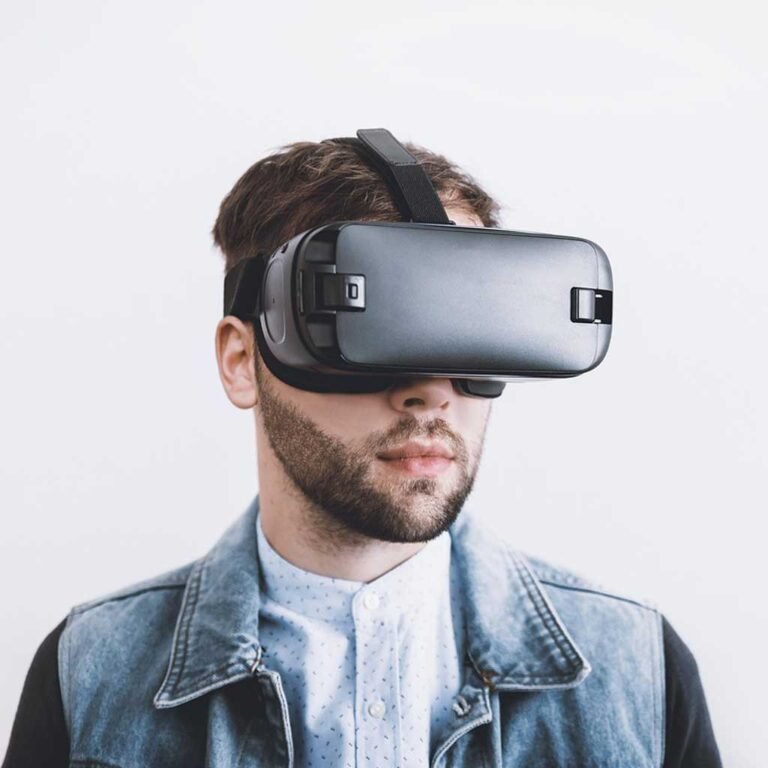
Enhancing Customer Experiences through Virtual Reality (VR) and Augmented Reality (AR)
Last updated: March 12, 2024 | Digital Techtune
In the contemporary era, the landscape of customer experience is continually evolving, driven by technological advancements. Among these, Virtual Reality (VR) and Augmented Reality (AR) stand out as transformative tools that have the potential to revolutionize how customers interact with products, services, and brands. This essay aims to explore the myriad ways in which VR and AR can enhance customer experiences across various industries.
Understanding Virtual Reality and Augmented Reality:
Before delving into their applications in enhancing customer experiences, it’s essential to grasp the concepts of VR and AR. Virtual Reality immerses users in a simulated environment, completely replacing the real world with a digital one. In contrast, Augmented Reality overlays digital content onto the real world, enhancing the user’s perception of reality. Both technologies have unique capabilities that can be harnessed to create compelling customer experiences.
Enhancing Product Visualization:
One of the most significant advantages of VR and AR in enhancing customer experiences is their ability to facilitate product visualization. Traditional shopping experiences often fall short in conveying the true essence of a product. However, with VR and AR, customers can interact with virtual or augmented representations of products, gaining a deeper understanding of their features and functionalities. For example, furniture retailers can offer VR experiences where customers can visualize how different pieces of furniture would look in their homes, helping them make more informed purchase decisions.
Personalized Engagement:
Personalization has become a cornerstone of modern customer experiences, and VR and AR can take personalization to new heights. These technologies enable brands to create tailored experiences that resonate with individual customers on a deeper level. By leveraging data analytics and AI algorithms, businesses can customize VR and AR experiences based on factors such as past purchase history, preferences, and browsing behavior. For instance, a fashion retailer could use AR to provide personalized styling recommendations to customers based on their body type and fashion preferences, fostering a stronger connection with the brand.
Interactive Storytelling:
Storytelling has always been a powerful tool for engaging customers, and VR and AR offer innovative ways to tell compelling stories. These technologies allow brands to create immersive narratives that captivate customers’ attention and evoke emotional responses. Whether it’s through virtual tours, interactive exhibitions, or augmented reality games, VR and AR can transport customers to new worlds and narratives, leaving a lasting impression. For example, museums can use AR to bring historical artifacts to life, allowing visitors to interact with virtual representations and learn about their significance in an engaging manner.
Virtual Try-On and Test Drives:
For industries such as fashion, cosmetics, and automotive, VR and AR offer the opportunity for virtual try-on and test drives, significantly enhancing the customer experience. With virtual try-on applications, customers can see how clothing, makeup, or accessories look on them without physically trying them on. Similarly, automotive companies can use VR to allow customers to test drive vehicles virtually, experiencing different features and configurations from the comfort of their homes. These immersive experiences not only streamline the decision-making process but also create memorable interactions that drive brand loyalty.
Enhanced Training and Education:
Beyond traditional customer interactions, VR and AR can also enhance training and education programs, indirectly impacting the customer experience. By providing employees with immersive training experiences, businesses can ensure that they deliver high-quality service and support to customers. For example, retail associates can undergo VR-based training simulations to hone their customer service skills and product knowledge, resulting in better assistance for shoppers. Similarly, educational institutions can leverage AR to create interactive learning experiences that cater to diverse learning styles, ultimately producing better-prepared graduates who can contribute positively to customer experiences in their respective fields.
Virtual Events and Experiences:
The rise of virtual events and experiences, accelerated by the COVID-19 pandemic, has further underscored the potential of VR and AR in enhancing customer engagement. Whether it’s virtual conferences, concerts, or exhibitions, these technologies enable brands to create immersive online experiences that rival their physical counterparts. Attendees can interact with virtual environments, engage with speakers or performers, and network with other participants, all from the comfort of their homes. By extending the reach of events and breaking down geographical barriers, VR and AR empower brands to connect with a global audience and deliver memorable experiences that drive brand awareness and loyalty.
Accessibility and Inclusivity:
One often overlooked aspect of VR and AR is their potential to improve accessibility and inclusivity in customer experiences. These technologies can bridge physical limitations and provide equal access to information and services for individuals with disabilities. For instance, AR navigation apps can assist visually impaired users in navigating unfamiliar environments by providing audio cues and directions. Similarly, VR simulations can offer immersive experiences that enable individuals with mobility impairments to explore inaccessible locations virtually. By prioritizing accessibility and inclusivity in the design of VR and AR experiences, businesses can foster a more inclusive customer environment and demonstrate their commitment to diversity and equality.
Social Interaction and Community Building:
In an increasingly digital world, fostering social interaction and community building is crucial for brands seeking to cultivate loyal customer bases. VR and AR offer unique opportunities for social engagement, allowing customers to connect with each other in virtual spaces and share experiences in real-time. Whether it’s through multiplayer games, virtual meetups, or collaborative projects, these technologies facilitate meaningful interactions that strengthen the bonds between customers and brands. For example, retail brands can host virtual shopping events where customers can explore products together, receive personalized recommendations, and engage in group activities, fostering a sense of belonging and camaraderie.
Challenges and Considerations:
While the potential of VR and AR in enhancing customer experiences is vast, several challenges and considerations must be addressed to realize their full benefits. Technical constraints, such as hardware limitations and compatibility issues, can hinder widespread adoption and scalability. Moreover, concerns related to privacy, data security, and ethical use of customer data must be addressed to build trust and ensure responsible implementation of VR and AR technologies. Additionally, the cost of developing and deploying VR and AR experiences can be prohibitive for some businesses, particularly small and medium-sized enterprises. Overcoming these challenges will require collaboration between technology providers, businesses, regulators, and other stakeholders to create a supportive ecosystem that fosters innovation and responsible use of VR and AR.
Virtual Reality (VR) and Augmented Reality (AR) have the potential to transform customer experiences across various industries. From enhancing product visualization and personalization to enabling interactive storytelling and virtual try-on experiences, these technologies offer innovative ways for brands to engage and delight customers. By leveraging VR and AR to create immersive, personalized, and inclusive experiences, businesses can differentiate themselves in a competitive marketplace and build lasting relationships with their customers. However, realizing the full potential of VR and AR will require overcoming technical, ethical, and financial challenges while prioritizing accessibility, inclusivity, and responsible use of customer data. Through collaboration and innovation, VR and AR have the power to shape the future of customer experiences and redefine the way we interact with brands in the digital age.

